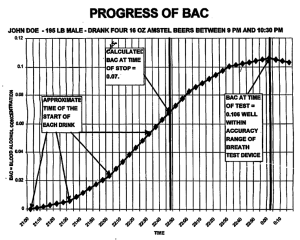The Rising Blood Alcohol Defense
Put simply, the rising blood alcohol defense alleges that a person was at a lower blood alcohol level at the time of driving and a higher blood alcohol level at the time of the DUI breath or blood test.
The Physiology of the Rising Blood Alcohol Defense
Alcohol is not absorbed instantly in the body. When a person consumes alcohol, it is processed by the body depending on the person’s physiology, metabolism, hydration levels, and most importantly, what the person had to eat and what that food in the stomach consisted of. From the stomach, the alcohol is processed in the small intestine, and the liver, and enters the bloodstream, where it can be measured by a breath test or a blood test.
The timing of the consumption of alcohol and the timing of eating can have a major effect on how the alcohol enters the body, and at what rate.
Alcohol in the body, to simplify a more complicated process, follows three stages:
- Absorption, which is the process where the alcohol level rises in the body;
- Peak (also known as peak absorption), the point where alcohol reaches the highest point, and the top of the curve, between absorption and dissipation; and
- Dissipation, which is the part of the process where the blood alcohol falls, until it reaches zero.
The photograph at the top of this page shows a smooth curve (or half a curve), which is the absorption part of the process, but there is a falling part of the curve later in time where the blood alcohol is eliminated by breath, sweat, or urine/feces, until alcohol is no longer in the blood.
That curve will be different for each case but will be steeper and reach a higher level upwards if there are drinks within a short period of time, and if there is no, or easily digested, foods in the system, like simple carbohydrates.
On the other hand, the curve will be lower as far as blood alcohol level, and the curve will extend for a longer period of time if there is drinking spaced out over a period of time, and food in the stomach high in fats or proteins, which are digested more slowly. Once there is food in the stomach, the alcohol will be digested and entered into the system at the same rate as the food is digested.
The timing of the Rising Alcohol Defense in DUI cases.
As you can see, the timing is important for a DUI attorney Orange County if a person is pulled over by the police for DUI. If the driver is still absorbing alcohol when they are pulled over and are then given a blood test or a breathalyzer test at any point after driving, the person’s blood alcohol content (BAC) will not accurately show their BAC — and will in fact show a higher blood alcohol level than the true alcohol level was at the time when they were driving.
Alcohol Blood Level At The Time of Driving
The only important alcohol level is what the driver had in their system at the time of driving. The laws are written to make impairment at the time of driving, or the blood alcohol level at the time of driving, the important time for legal purposes.
The Law of the Rising Blood Alcohol Defense.
The applicable law that is relevant to the rising blood alcohol defense is Vehicle Code section 23152(b), which makes it illegal to drive with a blood-alcohol level of .08% or more. That law states:
It is unlawful for a person who has 0.08 percent or more, by weight, of alcohol in his or her blood to drive a vehicle. For purposes of this article and Section 34501.16, percent, by weight, of alcohol in a person's blood is based upon grams of alcohol per 100 milliliters of blood or grams of alcohol per 210 liters of breath. In any prosecution under this subdivision, it is a rebuttable presumption that the person had 0.08 percent or more, by weight, of alcohol in his or her blood at the time of driving the vehicle if the person had 0.08 percent or more, by weight, of alcohol in his or her blood at the time of the performance of a chemical test within three hours after the driving.
A Rising Blood Alcohol Defense Example:
Don Driver has a beer at 8 pm, and another at 9 pm, and another at 10 pm. He ate a slice of pizza after the first drink. He is 185 pounds. After he finishes his last beer at 10:30 p.m., he gets in his car and is arrested shortly afterward, at 10:35 p.m.
At the time of driving, his drinking pattern shows that he would have been a 0.07% blood alcohol level, below the legal limit. However, his body is still absorbing alcohol, and his alcohol levels are rising.
However, after the stop and questioning by the DUI enforcement officer, and after his interview with the officer, and performance of his field sobriety tests, he is breath tested, at 11:00 pm, and shown to be a .10% blood alcohol level. Don is arrested for being DUI.
The defense, using a forensic toxicologist or other expert witnesses in a DUI, and documentation of the facts above, including drink receipts, or a witness to Don’s drinking, establishes the timing of his alcohol consumption, and that he was below a .08% at the time of driving, the important time legally.
Reasonable doubt is shown, and the DUI case is dismissed, and a DUI conviction is avoided, using the Rising Blood Alcohol Defense.
If you have questions for our Orange County DUI Lawyers, contact our firm by using our contact page or by calling (949) 682-5316.


